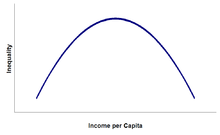Kuznets curve
The Kuznets curve (pronunciation: Kusnez ) is the graphical representation of the hypothetical relationship established by Simon Smith Kuznets between economic growth and inequality in income distribution. It says that economic inequality first increases during the development of a country and then decreases.
Explanations
The explanation made by Kuznets himself is based on an economy that is developing from an agricultural to an industrial society. At the beginning all workers are employed in agriculture and have roughly the same income. With the onset of industrialization, the profit potential of the factories is much higher than that of the landowner. The income of the average worker therefore falls compared to the profit of the average entrepreneur. The distribution of income between the poorest and richest in the population is thus becoming more unequal. In the course of industrialization, the profit opportunities in industry diminish, while the qualifications of workers enable them to negotiate high hourly wages - a market dynamic thus counteracts the originally growing inequality. Inequality also makes social programs likely, which are supposed to distribute wealth evenly. This reduces inequality again. Seen over time, the inequality develops in the form of an inverted U.
criticism
Until the 1970s, the Kuznets curve was a relatively undisputed relationship. In the 1980s and 1990s, however, inequality rose again in the OECD countries.
Numerous scientific papers refute the connection established by Kuznets since then.
Environment Kuznets curve
The Environmental Kuznets Curve (often also English Environmental Kuznets Curve , EKC for short ) is a hypothesis from environmental economics about the relationship between a country's per capita income and the level of environmental pollution. It states that the emissions of various environmental pollutants in a developing economy initially increase up to a peak and then decrease again as the per capita income continues to rise. Similar to the actual Kuznets curve, the EKC also has the shape of an inverted U.
The main possible explanations are:
- increasing income shifts people's preferences towards non-economic aspects, such as a cleaner environment;
- the development of a country from a relatively clean agricultural economy to a heavily polluting industrial society to a relatively environmentally friendly service society again; In terms of environmental economics, the technology effects of a service society are superimposed on the economies of scale of an emerging country
- Effects of international trade, such as the relocation of polluting industries to less developed countries,
- the establishment of new markets for natural resources in more developed countries and the associated pricing of natural resources,
- more effective regulation associated with economic growth,
- More recent considerations look for holistic approaches that cover all areas of social development: Increased financial leeway for the state in the course of economic development leads to an increase in environmental policy capacities, i. H. the creation of environmentally relevant institutions that promote both social awareness of environmental issues and an economic environment that produce environmentally friendly technologies.
Numerous studies have examined the presence of an EKC for different pollutants and countries. The results are very different and only partially confirm the assumed curve shape. The EKC has been confirmed for some air pollutants that have a direct impact on health, but not for greenhouse gas emissions. There are similar results for other environmental indicators, for example waste quantities, access to sanitary facilities or energy consumption: The EKC is more likely to be found when emissions are directly harmful to health, but not when primarily externalized damage occurs. For individual water-polluting substances, the environmental pollution had an N-shaped curve: after it had reached a low point, it increased again as the per capita income continued to rise. Often, econometric estimates for various types of environmental damage have not proven robust.
There is also empirical evidence that some developing countries are adopting and even exceeding environmental standards faster than developed countries.
Individual evidence
- ↑ Simon Kuznets: Quantitative Aspects of the Economic Growth of Nations. in: Economic Development and Cultural Change. 11. University of Chicago Press, Chicago 1963, OCLC 4731600 .
- ↑ Simon Kuznets: Economic Growth and Income Inequality . In: The American Economic Review . tape 45 , no. 1 , March 1955, p. 1–28 ( PDF ). PDF ( Memento of the original from August 18, 2015 in the Internet Archive ) Info: The archive link was inserted automatically and has not yet been checked. Please check the original and archive link according to the instructions and then remove this notice.
- ^ OECD Employment Outlook. OECD Publishing, Paris 1993, ISSN 1999-1266 , pp. 61-62.
- ^ Klaus Deininger , Lyn Squire: New ways of looking at old issues: inequality and growth . In: Journal of Development Economics . tape 57 , no. 2 , January 1998, pp. 259-287 , doi : 10.1016 / S0304-3878 (98) 00099-6 .
- ^ G. Fields: Distribution and Development, A New Look at the Developing World. Russel Sage Foundation, New York and MIT Press, Cambridge, Massachusetts and London, 2001.
- ^ Thomas Pogge : Global poverty as an institutional violation of human rights. in: Frankfurter Hefte . 12/2012; PDF
- ↑ a b c d e f g h Soumyananda Dinda: Environmental Kuznets Curve Hypothesis: A Survey . In: Ecological Economics . No. 49 , 2004, pp. 431-455 , doi : 10.1016 / j.ecolecon.2004.02.011 .
- ↑ Paul Kowitz: Capacity Building and the Environmental Kuznets Curve: Macro-quantitative and qualitative analysis of the development-environment relationship with special consideration of the capacity building in environmental policy. Shaker Verlag, Saarbrücken 2012.
- ↑ David I. Stern: The Environmental Kuznets Curve . In: Environmental Science (= Oxford Research Encyclopedias ). May 2017, doi : 10.1093 / acrefore / 9780199389414.013.401 .
- ↑ David I. Stern: The Rise and Fall of the Environmental Kuznets Curve . In: World Development . tape 32 , no. 8 , 2004, p. 1419–1439 , doi : 10.1016 / j.worlddev.2004.03.004 .
